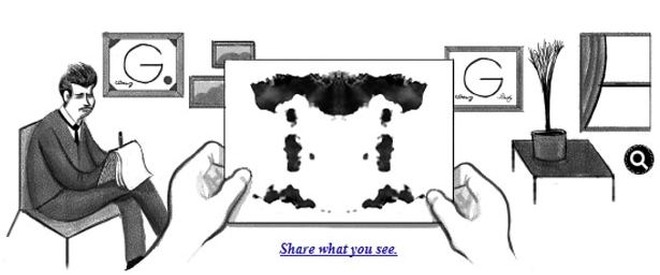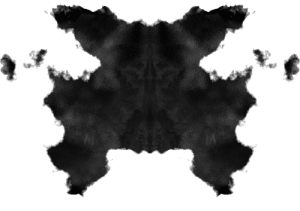Hermann Rorschach Google Doodle: The Inkblot Test
Hermann Rorschach Google Doodle

Google celebrated what would have been the 129th birthday of the Swiss psychologist, with a Hermann Rorschach Google Doodle on November 8th 2013. The Hermann Rorschach Google Doodle, which can still be viewed by clicking here, was in black and white and featured a cartoon depiction of Rorschach holding a pen and a pad, whilst a pair of hands held up an inkblot. Rorschach gained lasting fame for the creation of the “Inkblot Test”. The test asks participants to view 10 cards, which feature inkblots, and report what they see. Supporters of the Inkblot Test theory claim that the test can reveal hidden traits and characteristics about a participant. For example, the theory claims that participants who focus on the edges of the Inkblots have an obsessive personality.
The Hermann Rorschach Google Doodle featured numerous inkblots, which viewers could scroll through, viewers were then asked to share their observations of the inkblots through social media platforms, including Twitter and Facebook. The Hermann Rorschach Google Doodle inkblots included a number of mock inkblots, these included depictions of gnomes, dinosaurs and a butterfly floating above a cat’s head.

Hermann Rorschach was born in Zurich, Switzerland on November 8th 1884. He was the oldest of three siblings and spent much of his early life in Schaffhausen, a northern region of Switzerland. From an early age Rorschach enjoyed klecksography, the art of making inkblot pictures. This hobby earned Rorschach the childhood nickname of “Klecks” or “Inkblot”. Rorschach was encouraged to express himself artistically, through drawing and painting, from an early age by his father who was an art teacher.
As he approached graduation from secondary school, Rorschach was torn between pursuing a career in a science and one in art. He sought the advice of the famous German biologist, Ernest Haeckel in a letter. Haeckel, who throughout his career discovered, described and named thousands of new species, advised that the young Rorschach pursue a career in science.
Following the decision to become a scientist, Rorschach enrolled at the University of Zurich’s medical school. Whilst in Zurich, Rorschach began learning Russian. He graduated from the University of Zurich in 1907, in the same year he became engaged to Olga Stempelin. Stempelin was from the Russian region of Kazan, which is in the modern day Republic of Tatarstan, Russia. The couple married in 1913 and went to live in Russia. They had two children, a son, Wadin, who was born in 1919 and a daughter, Elizabeth who was born in 1917.
Rorschach spent a number of years studying under the tuition of Eugen Bleuler, who had previously taught Karl Jung. During his time as a medical student, Rorschach began to test inkblots on schoolchildren and analysed their responses. By July of 1914, Rorschach had returned to live in Switzerland. Whilst here he assumed the role of Assistant Director at the regional psychiatric hospital in Herisau.
In 1921 Rorschach wrote the book, “Physchodiagnostik”, the 174 page monograph contained his findings from the tests he had performed on mental patients. The book also contained the basis for the ten card test, which later became known as the Rorschach Test. An English translation of the text was not published until 1942. The English translation was published under the title, “Psychodiagnostics: A Diagnostic Test Based on Perception”.
Hermann Rorschach died extremely young, aged just 37, on April 1st 1922, just a year after the publication of his book. His death was attributed to peritonitis, which likely resulted from a ruptured appendix. Whilst the Rorschach test is widely known, it came under criticism in recent years, as a number of leading psychologists labelled the test as a “pseudoscience”, the test remains controversial.
